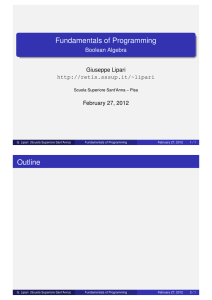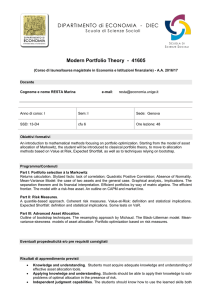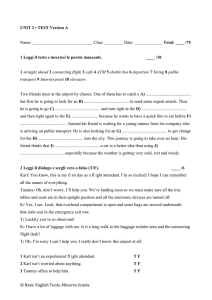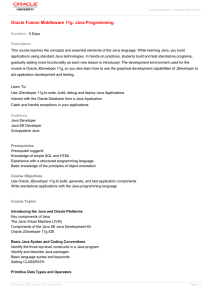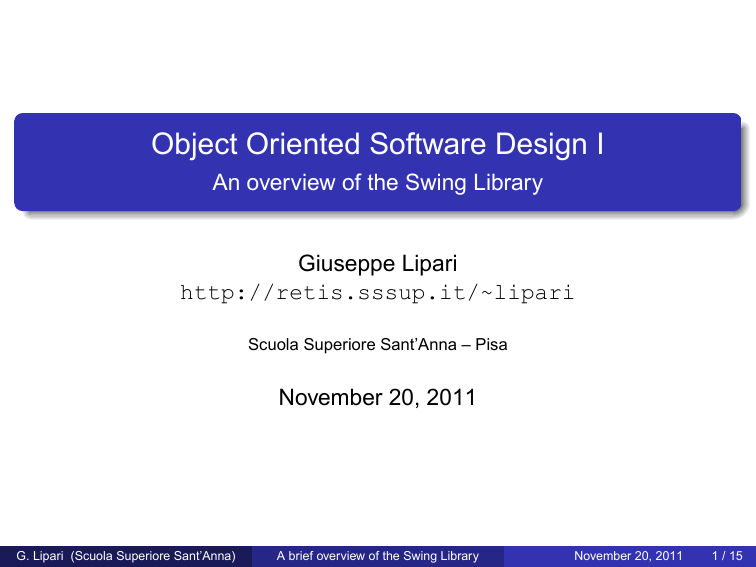
Object Oriented Software Design I
An overview of the Swing Library
Giuseppe Lipari
http://retis.sssup.it/~lipari
Scuola Superiore Sant’Anna – Pisa
November 20, 2011
G. Lipari (Scuola Superiore Sant’Anna)
A brief overview of the Swing Library
November 20, 2011
1 / 15
Outline
1
Why swing
2
Containers
3
Buttons
G. Lipari (Scuola Superiore Sant’Anna)
A brief overview of the Swing Library
November 20, 2011
2 / 15
Outline
1
Why swing
2
Containers
3
Buttons
G. Lipari (Scuola Superiore Sant’Anna)
A brief overview of the Swing Library
November 20, 2011
3 / 15
The JFC/Swing library
The JFC/Swing library provides a framework for building GUIs in
Java
JFC stands for Java Foundation Classes
Like all Java, Swing is portable across every platform
It provides classes for drawing windows, button, scrollbars, etc.
It provides ways to interact with the GUIs through the keyboard and
the mouse
It is built on top of the AWT library, which provides a basic
framework for low-level drawing on the screen
Pros
It’s portable and it’s distributed by Oracle together with the JRE and
JDK
Cons
Slow, and somewhat limited
G. Lipari (Scuola Superiore Sant’Anna)
A brief overview of the Swing Library
November 20, 2011
4 / 15
Swing framework
Many aspects of the Swing framework are built according to
well-known design patterns
Our goal is not to learn Swing, but rather to learn a little bit of it so
to identify the patterns that we have studied till now
A more complete introduction can be found in the Swing Tutorial
G. Lipari (Scuola Superiore Sant’Anna)
A brief overview of the Swing Library
November 20, 2011
5 / 15
Hello World in Swing
HelloWorld.java
import javax.swing.*;
public class HelloWorld {
// Create the GUI and show it.
private static void createAndShowGUI() {
//Create and set up the window.
JFrame frame = new JFrame("HelloWorld");
frame.setDefaultCloseOperation(JFrame.EXIT_ON_CLOSE);
//Add the ubiquitous "Hello World" label.
JLabel label = new JLabel("Hello World");
frame.getContentPane().add(label);
//Display the window.
frame.pack();
frame.setVisible(true);
}
public static void main(String[] args) {
createAndShowGUI();
}
}
G. Lipari (Scuola Superiore Sant’Anna)
A brief overview of the Swing Library
November 20, 2011
6 / 15
Outline
1
Why swing
2
Containers
3
Buttons
G. Lipari (Scuola Superiore Sant’Anna)
A brief overview of the Swing Library
November 20, 2011
7 / 15
Top containers
Inside a window, all widget are organised into “components”
organised into a hierarchy
To appear onscreen, every GUI component must be part of a
containment hierarchy. A containment hierarchy is a tree of
components that has a top-level container as its root.
Each top-level container has a content pane that, generally
speaking, contains (directly or indirectly) the visible components in
that top-level container’s GUI.
You can optionally add a menu bar to a top-level container. The
menu bar is by convention positioned within the top-level
container, but outside the content pane
G. Lipari (Scuola Superiore Sant’Anna)
A brief overview of the Swing Library
November 20, 2011
8 / 15
Containers
The top level container (or Frame) can be one of
JFrame, JDialog, JApplet
An example:
./examples/14.swing-examples/TopLevelDemo.java
Here is the containement hierarchy:
G. Lipari (Scuola Superiore Sant’Anna)
A brief overview of the Swing Library
November 20, 2011
9 / 15
Panels
The content panel is of type JPanel
It is possible to substitute the default content panel as follows:
//Create a panel and add components to it.
JPanel contentPane = new JPanel(new BorderLayout());
contentPane.setBorder(someBorder);
contentPane.add(someComponent, BorderLayout.CENTER);
contentPane.add(anotherComponent, BorderLayout.PAGE_END);
topLevelContainer.setContentPane(contentPane);
G. Lipari (Scuola Superiore Sant’Anna)
A brief overview of the Swing Library
November 20, 2011
10 / 15
Layout
Every panel has a layout that manages how the internal widgets
are organised in the available space
FlowLayout (default): all components
in a line from left to right
Grid Bag Layout: all components in a
grid, a component can span one or
more consecutive cells
Border Layout: five components in the
position shown in the figure
G. Lipari (Scuola Superiore Sant’Anna)
A brief overview of the Swing Library
November 20, 2011
11 / 15
JComponent
To add components to the panel, we use the method add(),
which takes a JComponent
All widgets (with the exception of top level containers) derive from
the JComponent class
For example, JPanel, JScrollPane, JButton, JTable,
JTextArea, etc.
Exercise:
draw a UML class diagram with the class hierarchy, including
JFrame, JComponent, JPanel, JButton
Observe the diagram: which pattern has been applied?
G. Lipari (Scuola Superiore Sant’Anna)
A brief overview of the Swing Library
November 20, 2011
12 / 15
Outline
1
Why swing
2
Containers
3
Buttons
G. Lipari (Scuola Superiore Sant’Anna)
A brief overview of the Swing Library
November 20, 2011
13 / 15
A button example
Let us see how it is possible to process commands, for example
clicks on buttons
See
./examples/14.swing-examples/SwingButtonExample.java
Exercise draw the containment hierarchy for this example
Observe the way clicks on JButton b1 are handled:
The class that wants to be informed of mouse clicks on b1 must
implement interface ActionListener
interface ActionListener {
void actionPerformed(ActionEvent e);
}
The ActionEvent class describes the event type (rarely used)
First, the ActionListener object is registered through the
addActionListener() function of JButton
When the button is clicked, method actionPerformed() of the
registered object is called
To install many buttons, we can create anonymous classes that just
handle the event
G. Lipari (Scuola Superiore Sant’Anna)
A brief overview of the Swing Library
November 20, 2011
14 / 15
Exercise
Draw the UML class diagram, including JButtons, interface
ActionListener, the Application, the anonymous classes
Name the pattern that had been used
G. Lipari (Scuola Superiore Sant’Anna)
A brief overview of the Swing Library
November 20, 2011
15 / 15

